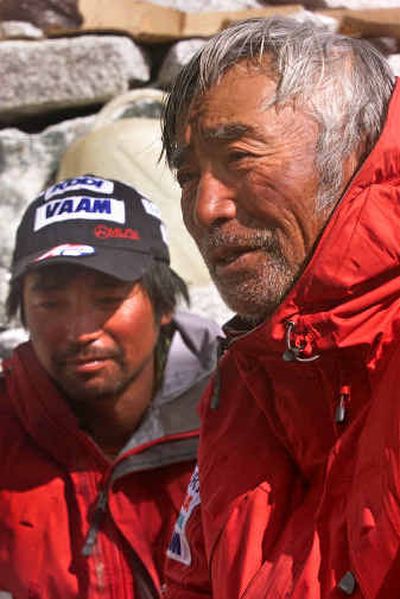More elderly Japanese living out vigorous lives

TOKYO – As dawn breaks over the world’s largest metropolis, Keizo Miura, a sinewy centenarian, is dressed in his gray tracksuit and pumped to sweat.
Before a hearty breakfast of seaweed and eggs, Miura races through his indoor exercises, wincing as his neck – still tender from a collarbone injury – momentarily reminds him that he was born in 1904. The man who has become a role model in graying Japan sucks it up, shaking off the pain the way he did last year when he skied down Europe’s Mont Blanc at age 99. In a Tokyo minute, he is out the front door for his daily two-mile power walk.
“I still feel good,” said Miura, who in 1981 became the oldest man to scale Mount Kilimanjaro, Africa’s tallest peak, and is training for an expedition to the Italian Alps next year. “There’s really nothing so amazing about me … but my son, now he is amazing.”
That would be Yuichiro Miura, 72, who in May 2003 became the oldest man to reach the summit of Mount Everest.
The Miuras are among the fast-growing ranks of super-seniors – Japan’s extraordinarily fit old folks. In a country where the average life span has extended to 81.9 years, Japan’s elderly are not only the longest-lived but statistically the healthiest seniors in the world. The typical Japanese now enjoys at least 75 years of relative good health, according to the World Health Organization. That exceeds by nearly six years the average for Americans – who rank 23rd.
“Older Japanese are remarkably healthy, doing things at their age that most youngsters couldn’t do,” said Yuichiro, who looks as if he could do arm curls with a neighborhood punk in each hand. “People over 65 here are climbing mountains, going to China to plant trees, traveling abroad to teach Japanese. It’s about diet, it’s about exercise. … It’s about making the most out of a long life.”
The extraordinary number of robust seniors means that many are able to embrace their twilight years with a gusto and sense of adventure.
This year, a group of 11 Japanese retirees – with an average age of 63 and a team leader clocking in at 78 – walked across China’s Taklimakan Desert along the ancient Silk Road. For 73 days, they trekked about 750 miles.
This month, Minoru Saito, 70, set sail in hopes of becoming the oldest man to circumnavigate the world alone without stopping at a single port.
A popular TV commercial features Minoru Nozoe, 68, a farmer, doing gymnastic twirls on the high bar.
With one in five citizens older than 65, spending by seniors – who on average have far more savings than most of their peers in the developed world – drives rising consumer demand as Japan emerges from a 13-year economic slump.
Without doubt, not all elderly Japanese are healthy, and their longevity is both a blessing and a curse. Along with the nation’s low birthrate, covering medical and pension costs for seniors is widely viewed as the most significant long-term problem confronting Japan. By 2017, an estimated 27 percent of the population will be older than 65, rising to 35.7 percent by 2050, according to the National Institute of Population and Social Security Research.
But government projections indicate that relatively robust seniors may at least help blunt some of those costs. Despite the high cost of living, for instance, medical costs per person for Japanese older than 65 are still slightly less than those for their American counterparts.
Studies indicate a multitude of reasons for the health of older people, with most citing a traditional diet heavy on fish and light on red meat, as well as the consumption of high-fiber rice. A national survey in 2000 showed that almost 63.6 percent of seniors don’t overeat, 49.6 percent exercise regularly and 64.2 percent sleep well. In rural areas, the elderly tend fields and gardens for hours a day. Urban seniors live active lives in cities such as Tokyo, where getting from place to place is often easier without a car.
“As opposed to America, seniors in Japan do not have to purposely go out and seek exercise – everyday life makes them more slim and healthy,” while they maintain very high nutrition, said Makoto Suzuki, a professor of human welfare at Okinawa International University. “It’s a winning combination.”